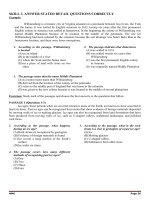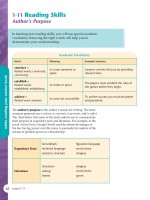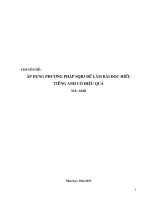Bài đọc hiểu tiếng anh
Bạn đang xem bản rút gọn của tài liệu. Xem và tải ngay bản đầy đủ của tài liệu tại đây (106.58 KB, 13 trang )
1. Hãy đọc đoạn văn sau và chọn câu trả lời tốt nhất trong số A, B, C và D.
Today I’d like to begin a discussion on the problem of the heating up the earth. First
we’ll touch on the relationship between fluorocarbons and the ozone layer. You probably
remember that the ozone layer is the protective shield around the earth. It is important to
all life, because it filters out harmful ultraviolet light from the sun. Ozone itself, a form of
oxygen, is regularly made by the action of the sun in the upper atmosphere. It is also
regularly destroyed by natural chemical processes.
The problem now is that too much of the ozone layer is being destroyed. Scientists
suspect that certain chemicals, such as fluorocarbons, are contributing to the depletion of
the ozone layer. And how do we use fluorocarbons? The most common uses are in spray
cans and cooling systems. The chemical pollution from these fluorocarbons can account
for some of the ozone losses that have been reported. There are, however, new studies
linking the sun itself to the depletion of the ozone layer. We’ll go into that new study
more next time.
1. Who is the most likely speaker?
A. A doctor
B. A mechanic
C. A professor
D. A chemist
2. What is the speaker’s main topic?
A. Ultraviolet light
B. The use of spray cans
C. Air-conditioning systems
D. Fluorocarbons and the ozone layer
3. What is the most important purpose of the ozone layer?
A. Providing fluorocarbons
B. Shielding the sun
C. Protecting the earth
D. Destroying chemicals
4. What is the ozone layer made of?
A. Fluorocarbons
B. Oxygen
C. Shields
D. Ultraviolet light
5. What will the speaker probably discuss next?
A. How to make air conditioners with fluorocarbons.
B. Harmful effects of ultraviolet light.
C. The makeup of the ozone layer.
D. The sun as a cause of ozone layer depletion.
2. Hãy đọc đoạn văn sau và chọn câu trả lời tốt nhất trong số A, B, C và D.
The search for alternative sources of energy has led in various directions. Many
communities are burning garbage and other biological waste products to produce
electricity. Converting waste products to gases or oil is also an efficient way to dispose of
waste.
Experimental work is being done to derive synthetic fuels from coal, oil shale and
coal tars. But to date, that process has proven expensive. Other experiments are underway
to harness power with giant windmills. Geothermal power, heat from the earth, is also
being tested.
Some experts expect utility companies to revive hydroelectric power derived from
streams and rivers. Fifty years ago hydroelectric power provided one third of the
electricity used in the United States, but today it supplies only four percent. The oceans
are another potential source of energy. Scientists are studying ways to convert the energy
of ocean currents, tides, and waves to electricity. Experiments are also underway to make
use of the temperature differences in ocean water to produce energy.
1. Which is the best title of the passage?
A. The Use of Water Productions for Energy.
B. The Search for Alternative Sources of Energy.
C. Efficient Ways of Disposing of Waste.
D. New Discoveries in Geothermal Power.
2. Fifty years ago one third of the electricity in the United States was provided by
_______.
A. wind
B. waste products
C. water
D. oil
3. In the second paragraph, the phrase “synthetic fuels” could best be replaced by which
of the following _______.
A. Biological fuels
B. Low burning fuels
C. Fast burning fuels
D. Artificial made fuels
4. Which of the following is NOT mentioned in the passage as an alternative source of
energy?
A. Burning of garbage
B. Geothermal power
C. Synthetic fuels
D. Electricity
5. According to the author, the impracticality of using coal, oil shale and coal tars as
sources of energy is due to _______.
A. their being time consuming
B. their being money consuming
C. the scarcity of sources
D. the lack of technology
3. Hãy đọc đoạn văn sau và chọn câu trả lời tốt nhất trong số A, B, C và D.
Computer programmer David Jones earned £35,000 a year designing new computer
games, yet he cannot find a bank prepared to let him have a cheque card. Instead, he has
been told to wait another two years, until he is 18.
The 16-year-old works for a small firm in Liverpool, where the problem of most
young people of his age is finding a job. David’s firm releases two new games for the
expanding home computer market each month.
But David’s biggest headache is what to do with his money. Despite his salary, earned
by inventing new programmes within tight schedules, with bonus payments and profitsharing, he cannot drive a car, take out a mortgage, or obtain credit cards.
He lives with his parents in their council house in Liverpool, where his father is a bus
driver. His company has to pay £ 150 a month in taxi fares to get him the five miles to
work and back every day because David cannot drive.
David got his job with the Liverpool-based company four months ago, a year after
leaving school with six O-levels and working for a time in a computer shop. “I got the job
because the people who run the firm knew I had already written some programmes,” he
said.
“I suppose £35,000 sounds a lot but actually that’s being pessimistic. I hope it will
come to more than that this year.” He spends some of his money on records and clothes,
and gives his mother £20 a week. But most of his spare time is spent working.
“Unfortunately, computing was not part of our studies at school,” he said. “But I had
been studying it in books and magazines for four years in my spare time. I knew what I
wanted to do and never considered staying on at school. Most people in this business are
fairly young, anyway.”
David added: “I would like to earn a million and I suppose early retirement is a
possibility. You never know when the market might disappear.”
1. Why is David different from other young people of his age?
A. He earns an extremely high salary
B. He is not unemployed
C. He does not go out much
D. He lives at home with his parents
2. David’s greatest problem is _______.
A. making the banks treat him as an adult
B. inventing computer games
C. spending his salary
D. learning to drive
3. He was employed by the company because _______.
A. he had worked in a computer shop
B. he had written some computer programmes
C. he works very hard
D. he had learnt to use computers at school
4. He left school after taking O-levels because _______.
A. he did not enjoy school
B. he wanted to work with computers and staying at school did not help him
C. he was afraid of getting too old to start computing
D. he wanted to earn a lot of money
5. Why does David think he might retire early?
A. You have to be young to write computer programmes.
B. He wants to stop working when he is a millionaire.
C. He thinks computer games might not always sell so well.
D. He thinks his firm might go bankrupt.
4. Hãy đọc đoạn văn sau và chọn câu trả lời tốt nhất trong số A, B, C và D.
Up to about 1915, movies were short and programmes were made up to several
works. Then D. W Griffith and others began making longer films which provided the
same powerful emotional appeal as did melodrama and presented spectacles far beyond
what the theatre could offer. Consequently, after World War I increasing numbers of
spectators deserted the theatre for the movies.
This trend was accelerated in the late 1920’s as a result of two new elements. In 1927
sound was added to the previously silent film, and thus one of the theatre’s principal
claims to superiority vanished. In 1929 a serious economic depression began. Since
audiences could go to the movies for a fraction of what it cost to see a play, theatre-going
became a luxury which few could afford, especially as the depression deepened.
By the end of World War II, the American theatre had been reduced to about thirty
theatres in New York City and a small number of touring companies originating there.
1. One thing that movies could do better than the theatre was _______.
A. provide longer programmes
B. provide emotional appeal
C. provide more melodrama
D. provide greater spectacles
2. Up to the 1920s one objection to films was that _______.
A. they were too short
B. they were silent
C. they were too expensive
D. they did not tell a complete story
3. One thing that made people choose the movies over the theatre was _______
A. World War I
B. the fact that films were less expensive
C. the fact that films were silent
D. the fact that films were shorter
4. By the end of World War II _______.
A. theatre had become entertainment for the mass
B. theatre-going was no longer considered a luxury
C. professional theatrical performances were confined mainly to New York City
D. there were no theatrical performances outside of New York City
5. When the author of this paragraph says “this trend was accelerated in the late 1920’s”,
he means that _______.
A. many more people went to the theatre than the movies
B. the shift away from the movies to the theatre was slowed down
C. the popularity of the theatre was gradually increasing
D. the shift away from the theatre to the movies was speeded up
5. Hãy đọc đoạn văn sau và chọn câu trả lời tốt nhất trong số A, B, C và D.
People commonly complain that they never have enough time to accomplish tasks.
The hours and minutes seem to slip away before many planned chores get done.
According to time management experts, the main reason for this is that most people fail
to set priorities about what to do first. They get tied down by trivial, time-consuming
matters and never complete the important ones.
One simple solution often used by those at the top is to keep lists of tasks to be
accomplished daily. These lists order jobs from most essential to least essential and are
checked regularly through the day to assess progress. Not only is this an effective way to
manage time, but also it serves to give individuals a much-deserved sense of satisfaction
over their achievements. People who do not keep lists often face the end of the work day
with uncertainty over the significance of their accomplishments, which over time can
contribute to serious problems in mental and physical health.
1. Which of the following is the best title for the passage?
A. Common Complaints About Work
B. Accomplishing Trivial Matters
C. Achieving Job Satisfaction
D. Learning to Manage Time
2. According to the passage, why do many people never seem to have enough time to
accomplish things?
A. They do not give priority to the tasks.
B. They get tied down by one difficult problem.
C. They fail to deal with trivial matters.
D. They do not seek the advice of time management experts.
3. In paragraph 2, the word those refers to _______.
A. daily lists
B. trivial matters
C. priorities
D. people
4. The passage states that one solution to time management problems is to _______
A. consult a time management expert
B. accomplish time-consuming matters first
C. keep daily lists of priorities and check them regularly
D. spend only a short time on each task
5. The paragraph following the passage most probably discusses _______
A. mental and physical health problems
B. another solution to time management problems
C. ways to achieve a sense of fulfillment
D. different types of lists
6. Hãy đọc đoạn văn sau và chọn câu trả lời tốt nhất trong số A, B, C và D.
By the end of the first quarter of the nineteenth century a number of our Eastern
institutions - Harvard, Yale, Columbia and Pennsylvania - had some of the necessary
ingredients of a university, but hardly yet the point of view. They were little clusters of
schools and institutes. Indeed, after the Revolution, the schools of Pennsylvania and
Harvard had assumed the somewhat pretentious title of university, and, shortly after, the
university of Virginia was founded under the guidance of Thomas Jefferson. In the South,
Georgia and later North Carolina began to rise. The substance in all these was mainly
lacking though the title was honored. There were rather feeble law, medical and divinity
schools, somewhat loosely attached to these colleges. It has been commonly recognized,
however, that the first decade after the close of the Civil War, that is, from about 1866 to
1876, was the great early flowering of the university in America.
1. In the opinion of the author in this passage, in 1825 _______.
A. only Harvard, Yale, Columbia and Pennsylvania could truly be called universities
B. all American educational institutions could justifiably claim to be universities
C. those institutions that called themselves universities were not justified in doing so
D. no American institutions of higher education had any of the necessary ingredients
of a university
4. Thomas Jefferson founded _______.
A. the university of Pennsylvania
B. Harvard
C. the university of Virginia
D. the university of Georgia
3. The Civil War ended _______.
A. about 1866
B. about 1876
C. about 1856
D. during the decade from 1866 to 1876
4. The words “little clusters” in the passage most nearly means _______.
A. small groups
B. small colleges
C. small buildings
D. small organizations
5. The university idea really began to develop _______.
A. in the first quarter of the nineteenth century
B. just after the revolution
C. during the last quarter of the nineteenth century
D. just after the Civil War
7. Hãy đọc đoạn văn sau và chọn câu trả lời tốt nhất trong số A, B, C và D.
SORE THROAT
Most sore throats are caused by an infection which treatment with antibiotics cannot
cure. But with simple remedies the patient normally gets better in 4 or 5 days.
Tonsillitis, however, usually starts with a sore throat which causes pain on
swallowing. With children - and some adults - there may be a fever and the patient is
obviously not feeling well. It may be possible to see while spots on the back of the throat.
The neck may also swell, both of which are the normal response to infection.
Sometimes a sore throat may occur with the common cold, and with influenza there
may be dryness of the throat, pain on coughing and loss of voice.
Treatment
Aspirin: To help relieve the pain on swallowing and (if there is one) the fever. Use aspirin
tablets dissolved in water so that the patient can gargle before swallowing. Repeat the
treatment every four hours.
Drink: Encourage the patient to drink plenty.
Food: Food should not be forced on a patient who does not want to eat. Steam: If there is
pain in throat on coughing, breathing in steam may help.
Children
Young children, who may not be able to gargle, should be given aspirin dissolved in
water every 4 hours in the right dose for their age.
At one year: A single junior aspirin.
At five years: Half an adult aspirin.
At eight years: One whole adult aspirin.
When to see the doctor:
If the sore throat is still getting worse after 2 days.
If the patient complains of earache.
If the patient’s fever increases.
If the patient or parent is very worried.
1. According to the passage it would appear that most sore throats _______
A. require an immediate visit to a doctor
B. respond quickly to treatment with an antibiotic
C. rarely turn out to be serious illnesses
D. result in tonsillitis even when treated
2. One of the signs of tonsillitis can often be _______.
A. difficulty in swallowing food and liquid
B. pain in the chest when coughing
C. white spots appearing on the neck
D. earache during the first four or five days
3. In order to treat a sore throat one should _______.
A. prevent the patient from eating too much
B. give the patient up to 4 aspirin tablets every hour
C. make certain the patient takes in plenty of liquid
D. make the patient gargle with hot liquid
4. You should call the doctor in if _______.
A. the infection spreads to another member of the family
B. swelling occurs in the region of the ears
C. the patient’s throat is still sore after two days
D. the patient’s condition continues to worsen
5. What difference is there in the way adults and young children should be treated with
aspirin?
A. Young children should not be allowed to gargle with it.
B. Adults should be given tablets to swallow whole.
C. Young children should be given aspirin more often than adults.
D. Adults should be given larger doses of aspirin than children.
8. Hãy đọc đoạn văn sau và chọn câu trả lời tốt nhất trong số A, B, C và D.
Scientists have established that influenza viruses taken from man can cause the
disease in animals. In addition, man can catch the disease from animals. In fact, a great
number of wild birds seem to carry the virus without showing any evidence of illnesses.
Some scientists conclude that a large family of influenza viruses may have evolved in the
bird kingdom, a group that has been on the earth 100 million years and is able to carry the
virus without contracting the disease. There is even convincing evidence to show that
virus strains are transmitted from place to place and from continent to continent by
migrating birds.
It is known that two influenza viruses can recombine when both are present in an
animal at the same time. The result of such recombinations is a great variety of strains
containing different H and N spikes. This raises the possibility that a human influenza
virus can recombine with an influenza virus from a lower animal to produce an entirely
new spike. Research is underway to determine if that is the way that major new strains
come into being. Another possibility is that two animal influenza strains may recombine
in a pig, for example, to produce a new strain which is transmitted to man.
1. According to the passage, scientists have discovered that influenza viruses _______.
A. cause ill health in wild birds
B. do not always cause symptoms, in birds
C. are rarely present in wild birds
D. change when transferred from animals to men.
2. What is known about the influenza virus?
A. It was first found in a group of very old birds.
B. All the different strains can be found in wild birds.
C. It existed over 100 million years ago.
D. It can survive in many different places.
3. New strains of viruses are transmitted to men by _______.
A. a type of wild pig
B. diseased lower animals
C. a group of migrating birds
D. a variety of means
4. It can be inferred from the passage that all of the following are ways of producing
new strains of influenza viruses EXCEPT _______.
A. two influenza viruses in the same animal recombining
B. animal viruses recombining with human viruses
C. two animal viruses recombining in one animal
D. two animal viruses recombining in a human
5. The passage would most likely be assigned reading for courses in which one of the
following subjects?
A. The History of Medicine
B. Medical Science
C. Botanical Science
D. Life Studies
9. Hãy đọc đoạn văn sau và chọn câu trả lời tốt nhất trong số A, B, C và D.
SHOPPING CENTRES
In many old cities in Europe, there are narrow twisting roads with many shops
huddling together along the two sides. These commercial places are not so modern and
convenient as those called shopping centres in modern cities, especially in the suburbs of
the big cities in the United States. Shopping centres have developed rapidly because of
the shift of the population to the suburbs, the growing use of and dependence upon the
automobile and the heavy traffic in downtown areas.
A shopping centre is a large group of stores facing a huge central enclosed mall which
may be covered, heated and air-conditioned. A shopping centre is also surrounded by a
parking area with space for thousands of cars.
We can buy all kinds of food and get anything we need in a shopping centre. Unlike a
supermarket, where groceries are chiefly sold, a shopping centre provides us with all
services besides food. We can get our hair cut, eyes examined, clothes washed; we can
book our tickets for a world tour and even enroll in special classes.
Shopping centres are, therefore, very convenient for customers, but they lack the “sense
of closeness” as felt in older commercial centres.
1. The rapid development of shopping centres is mainly due to _______
A. the fast-growing prosperity of suburban people
B. the increased use of the automobile
C. the growing use of heavy cars in big cities
D. the shift of the population to downtown areas
2. A shopping centre is a large group of stores facing a huge central mall which is
_______.
A. narrow and winding
B. very crowded with automobiles
C. used as a store-house for heaters and conditioners
D. shaded and comfortable
3. American shopping centres are especially established in the suburbs because
_______.
A. the customers want to avoid the heavy traffic in downtown areas
B. the traffic is heavier in the suburbs than in the downtown areas
C. there are few people moving from the downtown areas to the neighbouring regions
D. the streets in the downtown areas are so narrow and twisting
4. Customers can’t find the “sense of closeness” in a modern shopping centre because
_______.
A. all the items in the stores are very expensive
B. the shopkeepers are not very cordial
C. it is too modern and conventional
D. they worry too much about the safety of their cars
5. In the shopping sections of many old cities in Europe, the stores are located _______.
A. in the suburbs
B. in residential areas
C. along poor, dirty roads.
D. along small, winding streets









